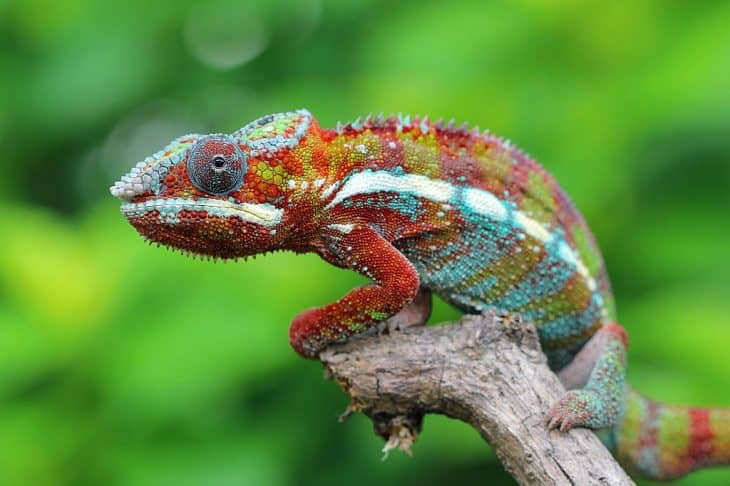
Chameleons are a unique group of lizards. Despite being at the bottom of the food chain, these fascinating reptiles are a unique species on their own. In particular, they are known for their ability to change colors, unusual methods of hunting prey, and resiliency. Not just that, they have quick tongues and even a fifth limb. Read on to find out more about these colorful lizards in these chameleon facts.
- There are more than 200 species of chameleons.
- 9 species of chameleons are listed as critically endangered.
- Around 20 species of chameleons are vulnerable to be endangered.
- 37 species of chameleons are listed as endangered.
- Chameleons are introduced to Florida, California, and Hawaii, California, and later kept as household pets.
- Most of the species can change their colors.
- Chameleons are arboreal. In other words, they spend most of their lives living in trees.
- Chameleons thrive in the arboreal environment due to their zygodactyl like feet (toes that are pointing forward and backward).
- The larger species of chameleons have a prehensile tail which they use for grasping or holding.
- The chameleon’s eyes have no upper or lower eyelid.
- Instead of having a lower and upper eyelid, chameleons have one big eyelid per eye with a cone-like shape.
- Their eyes can move in separate directions and it allows them to see from different angles.
- Chameleons love to live in warm habitats such as rain forests, lowlands, scrub savannas, mountains, and desert-like environments.
- The most common predators of chameleons are birds, snakes, and monkeys.
- Chameleons are almost near the bottom of the food chain and the smaller the chameleon is, the more likely it is to be eaten by its predators.
- Chamaeleonidae is the scientific name of the chameleon.
- Chameleons are clade (organisms that consist of a common ancestor).
- Old World lizards are the ancestor of the chameleons. “Old World” refers to Africa, Asia, and Europe.
- Chameleons are popular for their range of colors.
- Chameleons have close to 360 degrees vision, and they can look at two different things at the same time.
Chameleon Facts Infographics
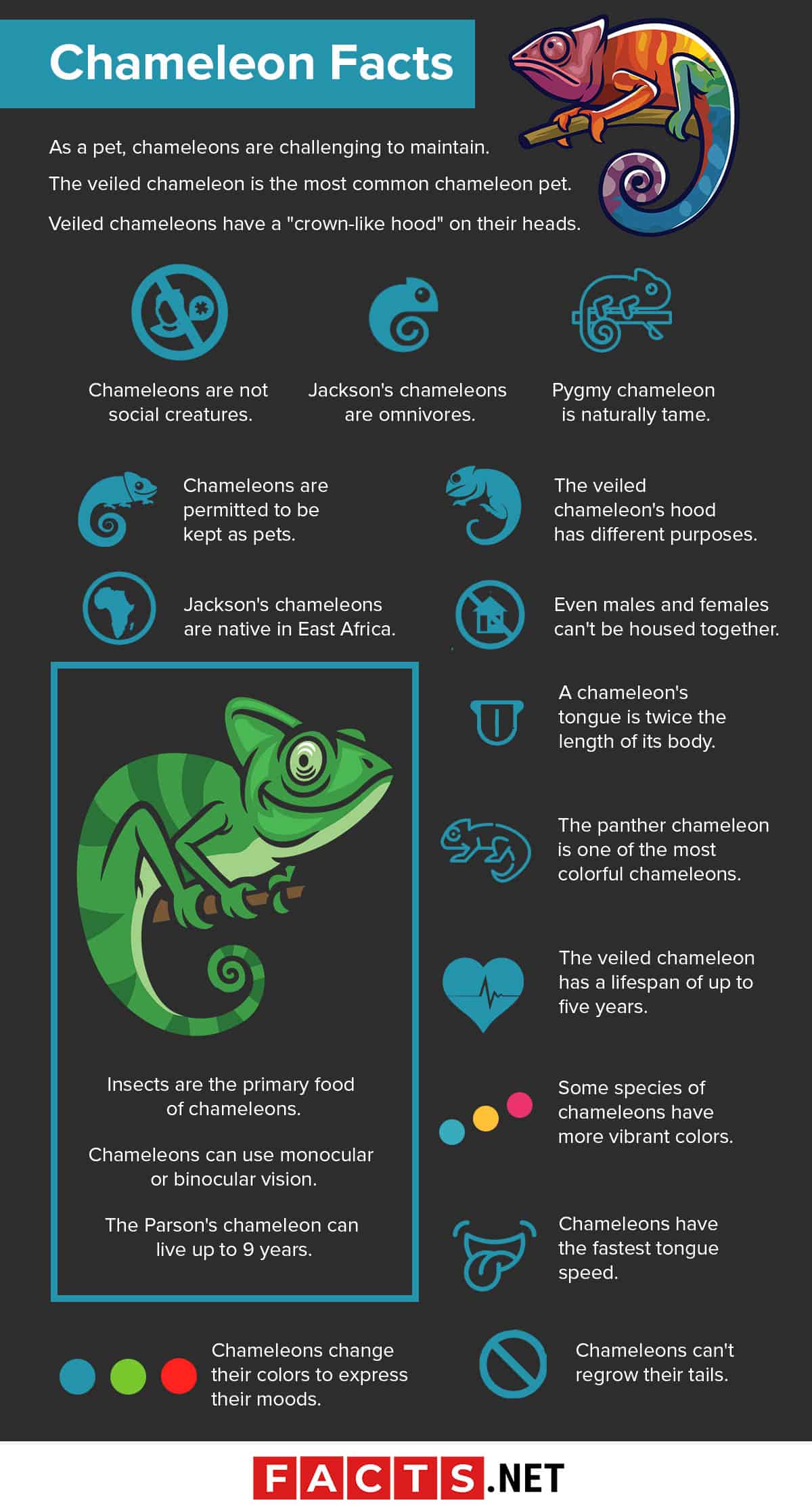
As a pet, chameleons are challenging to maintain.
In general, chameleons are not suitable for first-time pet owners because these creatures have complex needs and prone to stress. However, if you are a seasoned veteran reptile pet owner, then owning them shouldn’t be a problem for you.
Chameleons are permitted to be kept as pets.
The chameleon is a protected species and it’s illegal to capture them in the wild. However, they are permitted to be kept as pets, for breeding or to be sold with proper documentation. But remember, it is always important to double-check the rules and regulations according to your region if you plan to do so.
The veiled chameleon is the most common chameleon pet.
The veiled chameleons (also known as a cone-head chameleon or Yemen chameleon) are native to Saudi Arabia and Yemen. They are green in color and can have stripes with a variety of colors. Female veiled chameleon can grow only up to 35 centimeters, while the male can grow up to 61 centimeters. These chameleons are very sensitive about the temperature of their habitat and should be in a place with 70% humidity and a temperature 26-degree Celsius.
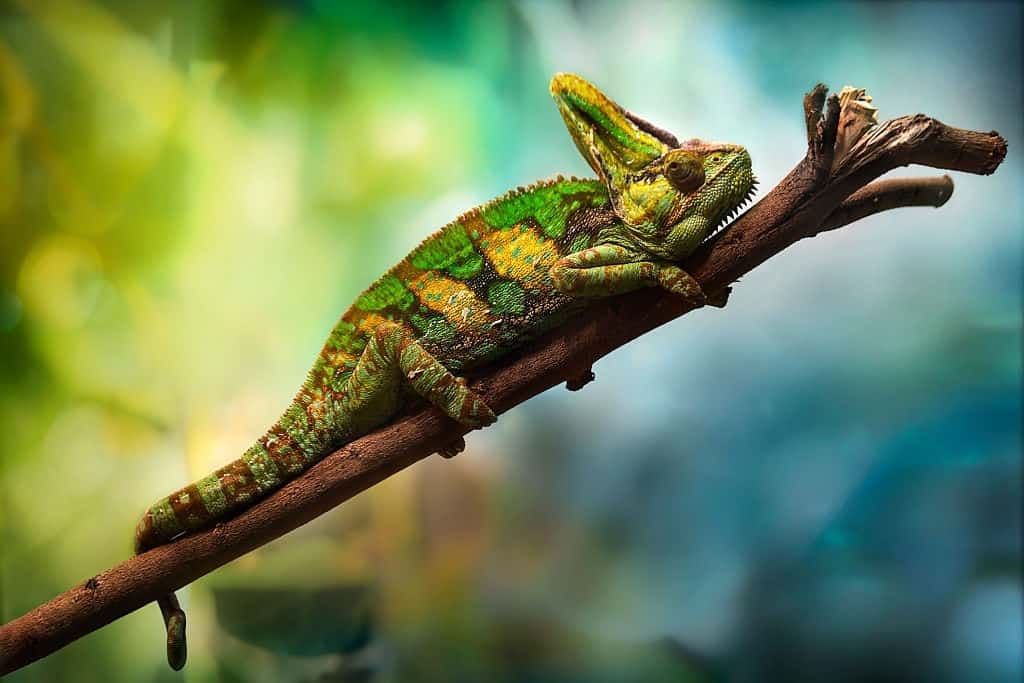
Veiled chameleons have a "crown-like hood" on their heads.
The veiled chameleon has a “crown-like hood” on the rear of its skull. The hood is a bony crest that can grow to about 5 centimeters. Both male and female chameleons have hoods, it’s just that the male chameleon’s hood is much bigger.
The veiled chameleon's hood has different purposes.
The veiled chameleon’s hood helps them to collect dew that becomes droplets of water. The water will eventually glide along the sides of the hood to the corner of the chameleon’s mouth. Furthermore, this hood serves as a protection when fighting with another male chameleon during the mating season. The bigger hood can intimidate other males to back off as females prefer a mate with larger hoods.
Jackson's chameleons are omnivores.
These species mostly feed on caterpillars, butterflies, ants, worms, slugs, snails, lizards, and even small chameleons. Occasionally, they are eating berries and leaves from trees.
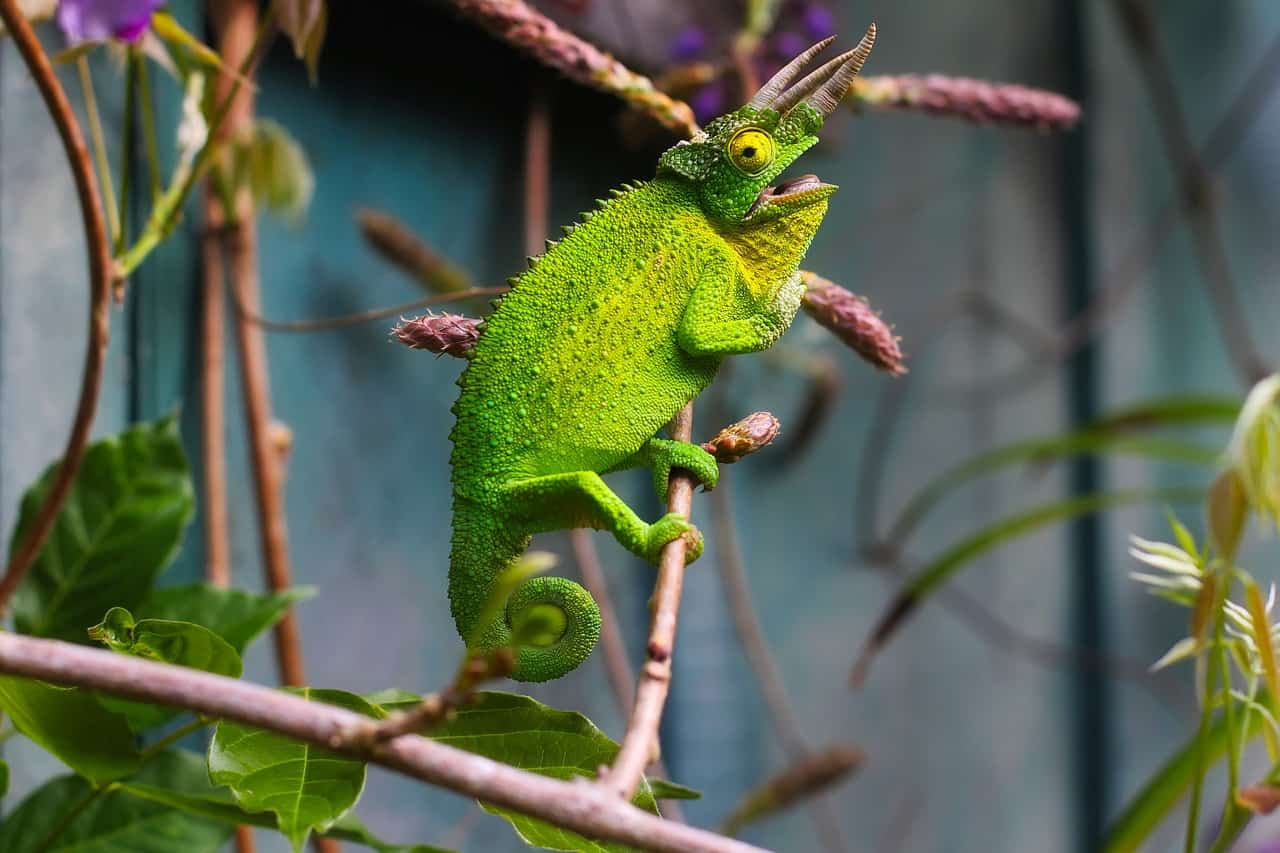
Jackson's chameleons are native in East Africa.
These East African natives are also common as pets and a good choice for beginners too. Jackson’s chameleon can grow between 9 to 12 inches. The perfect temperature for them is around 23 to 26-degree Celcius with 65% humidity.
Chameleons are not social creatures.
For instance, when two chameleons have visual contact, they may change their color in an instant. Chameleons are solitary animals, and if you have or plan to have a pet chameleon, it’s not a good idea to keep two male chameleons together for they will just fight with each other.
Even males and females can't be housed together.
It is also important to take note that even males and females can’t be caged or housed together. When they live together, they will threaten each other with hissing and bright coloration which will lead to fighting and wound injure each other.
Pygmy chameleon is naturally tame.
In contrast to most species of chameleons that are not social, the pygmy chameleon has a unique nature for it can stay in the cage with other chameleons. Moreover, a male can be with two females in a cage without any problem.
The panther chameleon is one of the most colorful chameleons.
The colorful panther chameleons are native in Northern and Eastern parts of Madagascar. Their colors vary from green, blue, yellow, orange, to red. These species can grow long up to 20 inches and can live from 5 to 7 years.
Insects are the primary food of chameleons.
Chameleons mostly eat insects such as crickets, mantis, grasshoppers, locusts, and stick insects. Moreover, the bigger species of chameleons can eat small birds and other lizards while a few species can even eat a little bit of plant material.
A chameleon's tongue is twice the length of its body.
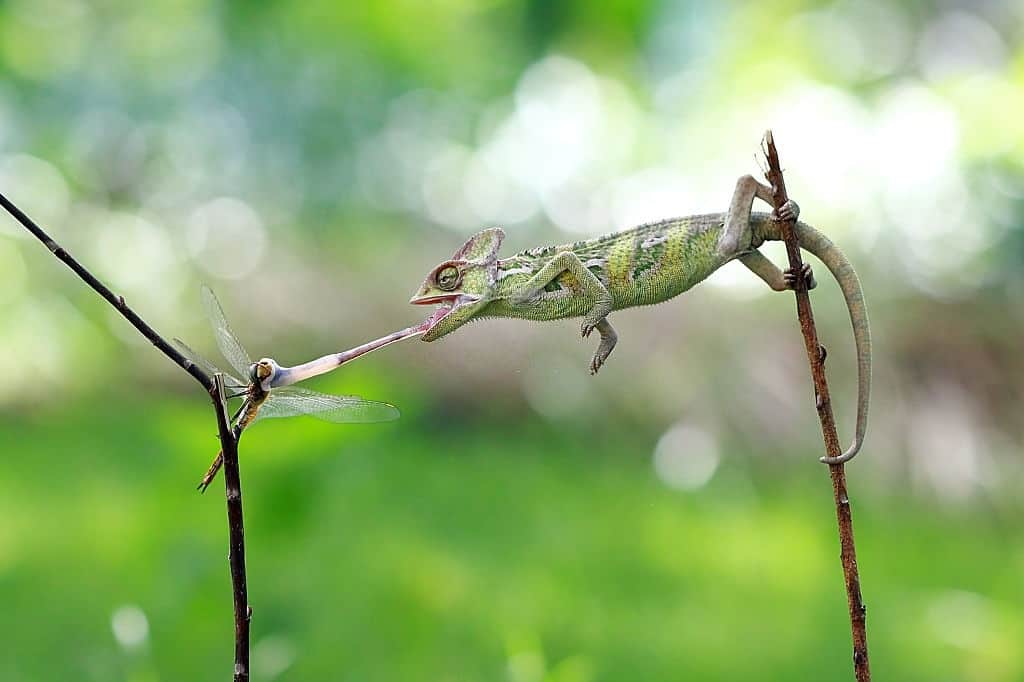
Chameleons have a long tongue. The surface of its tongue is sticky which they use to catch its prey. On average, the chameleon’s body length is around 11 to 20 inches, and the chameleon’s tongue is twice the length of its body.
Chameleons can use monocular or binocular vision.
The chameleon’s eyes can transition between monocular vision (both eyes are used separately) and binocular vision which enables them to perceive a single three-dimensional image of its surroundings.
The veiled chameleon has a lifespan of up to five years.
The lifespan of chameleons varies depending on its species. For instance, the veiled chameleon can live up to five years while the panther chameleon has an average lifespan of two to three years.
The Parson's chameleon can live up to 9 years.
The Parson’s chameleon is one of the chameleon species that has the longest lifespan along with Jackson’s chameleon which can range from five to ten years.
Some species of chameleons have more vibrant colors.
Some chameleon species can change their skin color and pattern through the combinations of orange, green, blue, brown, black, purple, turquoise, pink, red, light blue, and yellow.
Chameleons have the fastest tongue speed.
When hunting food, the chameleon’s tongue can go as fast as 95 kilometers per hour. Compared to reptiles and mammals, the chameleon’s tongue accelerates the fastest.
Brookesia Micra cannot grow more than 29 millimeters or 1.14 inches.
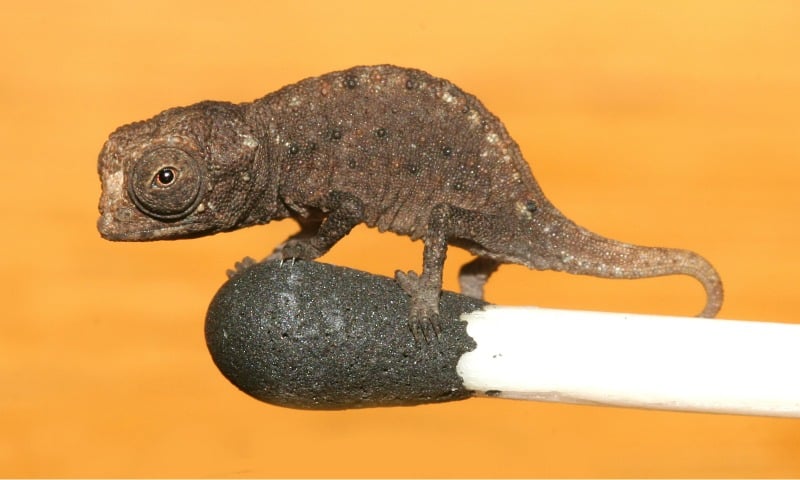
The smallest known chameleon species is the Brookesia Micra. These chameleons are only found on the small island of Nosy Hara (Islet in Madagascar) and have been named as the smallest chameleon species in the world.
Chameleons change their colors to express their moods.
Aside from being a master of disguise for blending into the surrounding, scientists have found out the real reason why they change their colors. According to the experts, these chameleons change colors not just to “camouflage” but its main purpose is to express their feelings or moods.
Chameleons have specialized cells called chromatophores.
The chromatophores are colorful pigments on the chameleons’ skin. These chameleons are changing their colors by forming and controlling their chromatophores when showing their moods. As a result, their skin is producing different colors.
Chameleons cannot produce their own body heat.
These chameleons are ‘ectotherms.’ In other words, they cannot control their body temperature and depend only on environmental heat sources. Their outer layer skin is transparent while under it are several layers of skin where the chromatophores lie. When sunbathing, these chameleon changes its color to a darker shade to warm more quickly.
Chameleons can't regrow their tails.
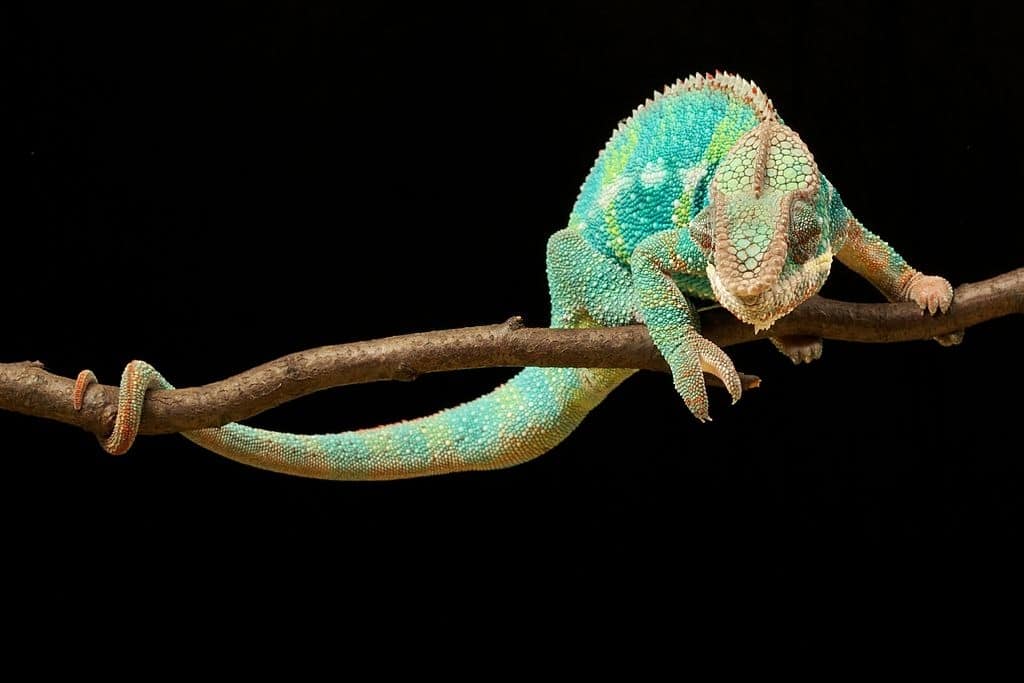
Compared to most lizards, a chameleon cannot regrow its tail once it is lost. Its tail serves a huge purpose as it works like its fifth limb. Chameleons use their tails to move between branches more easily, grasping, etc.
Chameleons don't drink a lot of water.
Although chameleons don’t drink much water, they do need constant access to it. A wild chameleon may drink from droplets on plants instead of looking for a pool or stream of water.
Chameleons use body language when communicating with one another.
They use body language or change their postures when they want to convey something, For instance, a chameleon would turn sideways if there is a trespasser to defend its territory. This allows them to look bigger and intimidating. If they feel a severe threat, it may open its mouth widely and hiss to frighten other chameleons or predators.
Chameleon means "earth lion."
The word ‘chameleon’ came from the Greek word ‘Chamai,’ which means on the earth, while ‘Leon’ means lion. Therefore, the word chameleon simply means “earth lion.”
Most species of chameleons lay eggs.
A mother chameleon digs a hole in the ground to her lay eggs and keeps them inside to make the eggs warm. Normally, a chameleon lays an average of 20 eggs (it can be more or less depending on the species). For instance, a veiled chameleon can lay for about 30 to 85 eggs. These eggs usually hatch between 6 to 9 months.
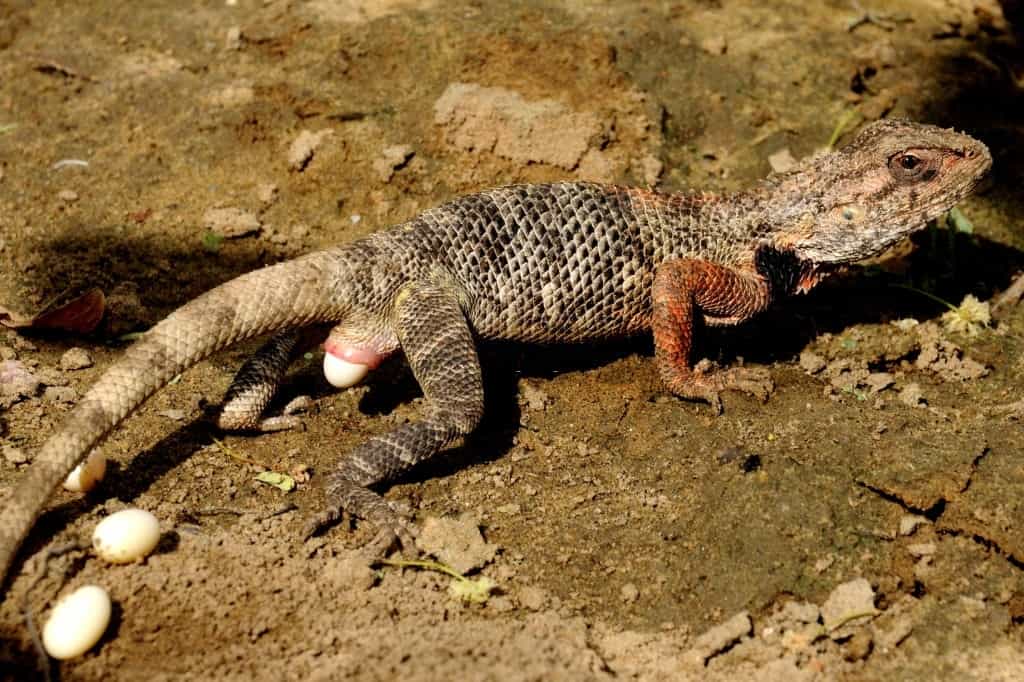
Some female chameleon species can hatch their eggs inside their body.
Although most chameleons lay eggs, there are a few species that can do it without. This includes Jackson’s chameleon that can produce 8 to 30 babies after bearing them for 4 up to 6 months. These baby chameleons started as eggs and stayed inside their mother until they are ready to be born.
Chameleons don't have a good sense of hearing.
Although chameleons have strong eyesight, they don’t have a good sense of hearing. Chameleons, like snakes, can only hear sounds at certain frequencies (200–600 Hz). Furthermore, they don’t have an outer or a middle ear nor an eardrum.
As pets, it's better to give them privacy.
Chameleons are territorial and aggressive by nature and it always good to keep in mind that if you have them as pets, regular handling tends to be stressful for them. Chameleons are pets that are much suited to be watched rather than handled.
Don’t forget to share these chameleon facts with your loved ones!
Was this page helpful?
Our commitment to delivering trustworthy and engaging content is at the heart of what we do. Each fact on our site is contributed by real users like you, bringing a wealth of diverse insights and information. To ensure the highest standards of accuracy and reliability, our dedicated editors meticulously review each submission. This process guarantees that the facts we share are not only fascinating but also credible. Trust in our commitment to quality and authenticity as you explore and learn with us.
